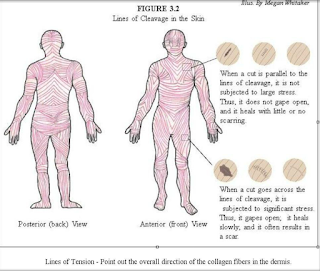Chest Pain Differential Diagnosis
Originally posted 12/2017
Chest pain may be
caused by a number reasons including but not limited to issues related to the
cardiovascular, respiratory, gastrointestinal, and musculoskeletal systems as
well as of a psychogenic origin. Chest pain differential diagnosis entails
gathering patient history and signs and symptoms to determine a potential
origin, and formulating a working field impression or working diagnosis.
Symptoms are the
subjective data provided the patient to include the familiar mnemonic OPQRST Onset
of symptoms and activities leading up to event, Provocation and Palliation, Region
of pain/discomfort and any Radiation, Severity and Time of onset including
changes overtime and if have experienced previously. It is important to gather as much detail about the
symptoms as possible as not all patients will present with typical or classic
signs. This is particularly relevant for female patients which may present with
atypical signs/symptoms for myocardial infarction (MI).
History will
include information pertaining to the current information (History of Present
Illness) as well as past medical and if known family history. Items of note
will be age of patient, personal relevant medical information such as cardiac,
respiratory, trauma, recent illnesses to include fever and infections, medications
prescribed and over-the-counter (OTC), alcohol, street drug use, changes to
dietary and activity, recent travel, recent stress. For treatments, it is important to determine
if patient is taking vasodilating or anticoagulation medications as well as
aspirin and other Nonsteroidal Anti-inflammatory Drugs (NSAID) use. Patients
may have a history or family history of heart disease or related factors such
as elevated blood pressure, elevated cholesterol, may have EKG
abnormalities/changes or co-morbidities such as diabetes, vascular disease,
etc.
Common Cardiovascular Causes
Cardiovascular
causes of chest pain include angina pectoris which occurs with insufficient
myocardial perfusion typically characterized with sudden pain onset typically
occurring during or after activity or stress induced that may or may not
radiate and may decrease in intensity after rest, may also have nausea,
shortness of breath, dizziness, and/or diaphoresis.
Another cause of
chest pain includes myocardial infarction involving an infarct also known as an
occlusion partial or total of one or more of the arteries supplying the heart.
Symptoms include acute onset of pain typically chest (midsternal, substernal,
epigastric) or back between scapula which may radiate to arm(s), neck, jaw,
and/or across chest. Pain may last minutes to days and may be associated with
shortness of breath, diaphoresis, nausea and/or dizziness. The classic presentation is sudden left chest
pain described as “an elephant sitting on my chest” radiating into left arm
and/or jaw with shortness of breath, nausea, dizziness, and diaphoresis. An
atypical presentation may be gradual onset of pain over time getting
progressively worse, feeling run down, shortness of breath worse on exertion
with pain between shoulder blades.
Another cause of
chest pain is an aortic dissection – a life threatening condition where the
inner layer of the aorta have torn allowing blood to flow between the vessel
layers. Typically, pain is sudden, sharp, “tearing” sensation, may originate in
the chest or abdomen may involve radiation and may be constant, intermittent or
a combination. May be accompanied by nausea, dizziness, diaphoresis and may
have a pulsating mass present in abdomen. Patient may have history of aneurysm
(a weakening of aortic wall resulting in a bulging).
Common Respiratory Causes
Common
respiratory causes include pneumothorax – “collapsed lung”, a build-up of air
between the lung and chest wall (pleural space). Typically, sudden onset of lateral chest pain,
worse with deep inspiration, movement and activity, decreased or shallow depth
of breathing and dyspnea. May be associated with trauma, may have absent or
diminished lung sounds. Contributing factors for spontaneous pneumothorax
include being young male, smoker, tall thin, congenital defects such as Marfan
Syndrome, family history, lung diseases including COPD.
Another pulmonary
cause includes pulmonary embolism, a blood clot(s) lodged in a pulmonary artery
or arteries. Symptoms include sudden chest pain, typically laterally, worse
with deep breaths, may be accompanied with dyspnea, dizziness, hemoptysis,
hypoxia, cyanosis, diaphoresis, and/or jugular vein distention (JVD).
Contributing factors include, personal and family history or blood clots,
coagulopathies, smoking, birth control medications, inactivity associated with
cramped seated long-distance travel and/or recent surgeries.
Infection of lung
tissues and/or pleural and visceral linings is an additional cause of chest
pain, pulmonary in nature. Symptoms may include gradual onset of pain, increased
pain with position and/or deep inspiration, pain may be localized over affected
position, fever, chills, productive cough, dyspnea, diaphoresis, shallow
breathing, decreased and/or adventitious breath sounds. History of recent URI,
infection.
Musculoskeletal
Musculoskeletal
causes of chest pain may present as gradual or sudden onset, typically
associated with activity or injury with provocation of palpation, activity,
and/or position. Pain may
also be less
diffuse and may have radiation. Associated symptoms may also include nausea,
shortness of breath and/or diaphoresis.
Nagurney, J. (2015). Chest pain differential diagnosis. Loyola EMS. Retrieved from
https://loyolaems.com/ce/ce_jan15.pdf


